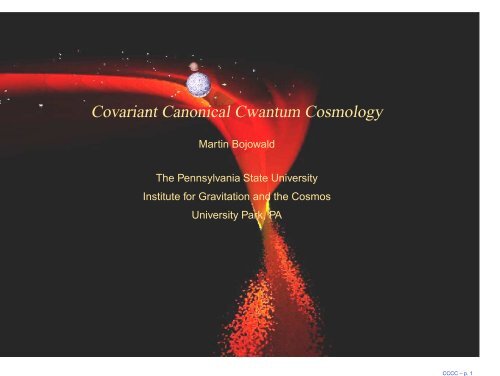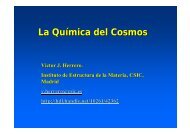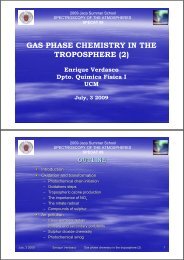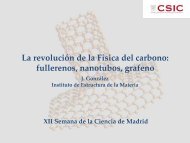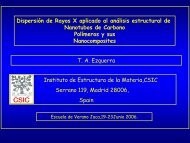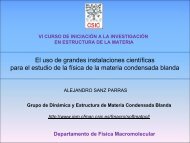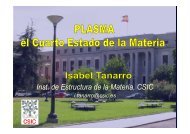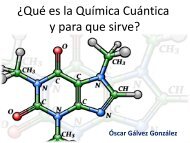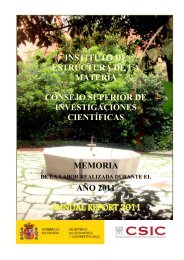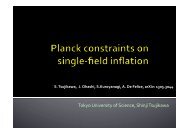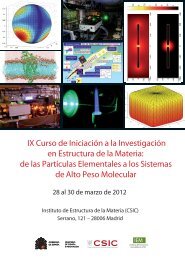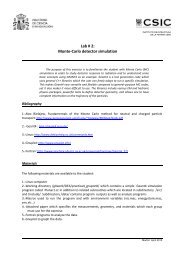Download the slides
Download the slides
Download the slides
Create successful ePaper yourself
Turn your PDF publications into a flip-book with our unique Google optimized e-Paper software.
CCCC – p. 1<br />
Covariant Canonical Cwantum Cosmology<br />
Martin Bojowald<br />
The Pennsylvania State University<br />
Institute for Gravitation and <strong>the</strong> Cosmos<br />
University Park, PA
CCCC – p. 2<br />
Background independence<br />
Background independent quantizations of gravity must show that<br />
some form of space-time “emerges” at sufficiently low curvature.<br />
Not guaranteed.<br />
Canonical approaches: constraints are quantized, receive<br />
quantum corrections. Not just dynamics but also space-time<br />
structure (gauge content) may change.<br />
S = 1<br />
16πG<br />
∫<br />
d 4 x √ |detg|<br />
(<br />
)<br />
R+αR 2 +βR ab R ab +···<br />
?<br />
Must know space-time structure before deciding which covariant<br />
combinations of metric derivatives can appear.<br />
Not just R may receive quantum corrections but also “d 4 x,” or<br />
nature of covariance and space-time tensors.
CCCC – p. 3<br />
Loop quantum gravity<br />
−→ Holonomies h e = exp( ∫ e dλAi aė a τ i ) along curves e in space.<br />
Represented as operators, but not continuous in connection.<br />
No connection operator.<br />
−→ Holonomies as ladder operators raise excitation level of<br />
geometry by discrete steps.<br />
Densitized triad quantized as flux ∫ S d2 yn a Ê a i for surfaces S in<br />
space, with discrete spectrum containing zero.<br />
−→ Spatially diffeomorphism invariant: sum over all deformed<br />
graphs. Background independent: No metric used in basic<br />
operators.<br />
More tricky: Space-time covariance, Hamiltonian constraint.<br />
Background independence often forsaken at this stage.
CCCC – p. 4<br />
Quantum corrections<br />
−→ Inverse-triad corrections from quantizing [T Thiemann 1996]<br />
{ } √|detE|d<br />
Aa,∫ i 3 x<br />
= 2πGǫ ijk ǫ abc<br />
E b j Ec k<br />
√<br />
|detE|<br />
2.5<br />
Automatic cut-off of<br />
1/E-divergences.<br />
α (r)<br />
−→ Higher-order corrections:<br />
holonomies for A i a<br />
−→ Quantum back-reaction<br />
2<br />
1.5<br />
1<br />
0.5<br />
0<br />
0 0.5 1 1.5 2<br />
µ<br />
flux eigenvalues<br />
r=1/2<br />
r=3/4<br />
r=1<br />
r=3/2<br />
r=2
CCCC – p. 5<br />
Hypersurface-deformation algebra<br />
Diffeomorphism constraint D[w a ] and Hamiltonian constraint H[N].<br />
Classical algebra<br />
{D[w a 1],D[w a 2]} = −D[L w2 w a 1]<br />
{H[N],D[w a ]} = −H[w a ∇ a N]<br />
{H[N 1 ],H[N 2 ]} = D[h ab (N 1 ∇ b N 2 −N 2 ∇ b N 1 )]<br />
ensures that <strong>the</strong>ory respects<br />
→ gauge transformations for coordinate changes: space-time<br />
Lie derivative {f,H[ǫ]+D[ξ a ]} = L (ǫ/N,ξa +ǫN a /N)f if<br />
constraints satisfied and time direction t a = Nn a +N a . [Dirac]<br />
→ slicing independence: algebra amounts to deformations of<br />
hypersurfaces<br />
[Kuchar, Teiltelboim]<br />
Anomaly-free quantum-corrected constraints generate modified<br />
gauge transformations. Space-time?
CCCC – p. 6<br />
Background independence?<br />
Status of background independence in loop quantum gravity:<br />
(+) No spatial background metric used to define states and<br />
operators, summed over spatial diffeomorphisms.<br />
Uniqueness of representation.<br />
(−) Hamiltonian constraint quantized in much more messy way.<br />
Modify classical expression by holonomy corrections<br />
(quantum corrections mixed with regulator).<br />
(−) Diffeomorphism constraint and Hamiltonian constraint<br />
contain curvature of A i a, but treated differently.<br />
(−) Off-shell algebra of Hamiltonian constraints often ignored.<br />
[see also H Nicolai, K Peeters, M Zamaklar: hep-th/0501114]<br />
Can this procedure result in any consistent space-time picture?<br />
Energy conservation?
CCCC – p. 7<br />
Energy conservation<br />
[with M Kagan, G Hossain, C Tomlin: arXiv:1302.5695]<br />
N √ deth∇ µ T µ 0 = −N ∂H matter<br />
∂t<br />
−N a∂Dmatter a<br />
∂t<br />
+L ⃗N C matter [N,N a ]+ ∂h ab<br />
∂t<br />
+∂ b<br />
(<br />
N 2 h ab D matter<br />
a<br />
δH matter<br />
δh ab<br />
)<br />
+2N c h baδH matter<br />
δh ac<br />
Classical off-shell algebra: ∂H matter /∂t = {H matter ,H[N,N a ]}<br />
cancels ∂ a (N 2 D matter<br />
a ), only one term from ∂ b T b 0.<br />
→ Deformed algebra cannot be taken care of by modified<br />
coefficients in ∇ µ T µ ν = 0.<br />
→ No energy conservation if off-shell algebra broken<br />
(or unchecked in gauge-fixed/deparameterized models).
CCCC – p. 8<br />
Consistent loop quantum gravity<br />
→ Off-shell closed operator algebra of constraints likely?<br />
→ Semiclassical states (at dynamical level)?<br />
More realistic (at least in particle-physics analogy):<br />
Effective equations.<br />
→ Ease subtleties of factor ordering and quantum<br />
representation.<br />
→ Describe general classes of semiclassical states without<br />
requiring full wave function.<br />
(Vacuum problem of quantum gravity.)<br />
→ Can be generalized to constrained systems. Allow local<br />
internal times and time changes by gauge transformations.<br />
→ Simpler derivation of closed constraint algebras.<br />
But still incomplete.
CCCC – p. 9<br />
Effective canonical dynamics<br />
Parameterize state by expectation values 〈ˆq〉 and 〈ˆp〉 of basic<br />
operators and moments<br />
(Includes mixed states.)<br />
G a,n = 〈(ˆq −〈ˆq〉) a (ˆp−〈ˆp〉) n−a 〉 symm<br />
Commutator of operators determines Poisson bracket of<br />
moments. (Symplectic space, but not after restriction to finite n.)<br />
Expectation value of Hamiltonian, interpreted as function of 〈ˆq〉,<br />
〈ˆp〉 and G a,n , provides canonical equations of motion.<br />
Effective equations: Correct classical equations for 〈ˆq〉, 〈ˆp〉 by<br />
quantum back-reaction from moments.<br />
[with A Skirzewski: math-ph/0511043]
CCCC – p. 10<br />
Quantum equations of motion<br />
Anharmonic oscillator:<br />
˙q = p m<br />
ṗ = −mω 2 q −U ′ (q)− ∑ n<br />
1<br />
n!<br />
( ) n/2<br />
U (n+1) (q)˜G 0,n<br />
mω<br />
˙˜G a,n = −aω ˜G a−1,n +(n−a)ω ˜G a+1,n −a U′′ (q)<br />
mω<br />
√<br />
aU ′′′ (q)<br />
+<br />
2(mω) 3 2<br />
(√<br />
U ′′′ (q)<br />
− a 2<br />
(mω) 3 2<br />
˜G<br />
a−1,n<br />
˜G a−1,n−1 ˜G0,2 (q)<br />
+ aU′′′′ a−1,n−1 ˜G ˜G0,3<br />
3!(mω) 2<br />
˜G a−1,n+1 + U′′′′ (q)<br />
3(mω) 2 ˜G a−1,n+2 )<br />
∞ly many coupled equations for ∞ly many variables.<br />
+···
CCCC – p. 11<br />
Low energy effective action<br />
To second adiabatic order, as second order equation of motion:<br />
( )<br />
as it results from<br />
Γ eff [q(t)] =<br />
m+<br />
U ′′′ (q) 2<br />
32m 2 ω 5 (1+ U′′ (q)<br />
mω 2 ) 5 2<br />
+ ˙q2 (<br />
4mω 2 U ′′′ (q)U ′′′′ (q)<br />
+mω 2 q +U ′ (q)+<br />
(<br />
¨q<br />
128m 3 ω 7 (1+ U′′ (q)<br />
mω 2 ) 7 2<br />
) )<br />
1+ U′′ (q)<br />
mω 2 −5U ′′′ (q) 3<br />
U ′′′ (q)<br />
4mω(1+ U′′ (q)<br />
mω 2 ) 1 2<br />
= 0.<br />
∫ ( (<br />
)<br />
1 U ′′′ (q) 2<br />
dt m+<br />
2 2 5 m 2 (ω 2 +m −1 U ′′ (q)) 5 2<br />
− 1 2 mω2 q 2 −U(q)− ω ( )<br />
)1<br />
1+ U′′ (q)<br />
2<br />
2 mω 2<br />
˙q 2
Higher time derivatives<br />
Higher adiabatic order:<br />
[with S Brahma, E Nelson: arXiv:1208.1242]<br />
¨q = −ω 2 q −U ′ (q)/m<br />
where<br />
− <br />
2m 2 ω U′′′ (q) ( f(q, ˙q)+f 1 (q, ˙q)¨q +f 2 (q)¨q 2 +f 3 (q, ˙q)˙¨q +f 4 (q)¨q )<br />
+···<br />
( ) −1/2 ( ) −5/2<br />
f(q, ˙q) = 1 2<br />
1+ U′′ (q)<br />
mω +<br />
U ′′′′ (q)˙q 2<br />
2 16mω<br />
1+ U′′ (q)<br />
4 mω −<br />
5(U ′′′ (q)) 2 ˙q 2<br />
2 64m 2 ω<br />
(1+ 6<br />
( ) −7/2 ( ) −9/2<br />
− U′′′′′′ (q)˙q 4<br />
64mω<br />
1+ U′′ (q)<br />
6 mω +<br />
21(U ′′′′ (q)) 2 ˙q 4<br />
2 256m 2 ω<br />
1+ U′′ (q)<br />
8 mω 2<br />
( ) −9/2 (<br />
+ 7U′′′′′ (q)U ′′′ (q)˙q 4<br />
64m 2 ω<br />
1+ U′′ (q)<br />
8 mω −<br />
231U ′′′′ (q)(U ′′′ (q)) 2 ˙q 4<br />
2 512m 3 ω<br />
1+ U′′ (q<br />
10 mω 2<br />
( ) −13/2<br />
+ 1155(U′′′ (q)) 4 ˙q 4<br />
4096m 4 ω<br />
1+ U′′ (q)<br />
12 mω 2 CCCC – p. 12
CCCC – p. 13<br />
Effective constraints<br />
Dynamics by effective Hamiltonian<br />
constraints 〈̂polĈ〉(〈·〉,∆(·)).<br />
→ Captures dynamics<br />
of physical states.<br />
→ Allows local internal times.<br />
[arXiv:1009.5953]<br />
[Figure from arXiv:0911.4950]<br />
Α 0<br />
〈Ĥ〉(〈·〉,∆(·)) or effective<br />
p Α<br />
Α 0<br />
Α 0<br />
.5Α 0<br />
.5Α 0<br />
.5Α 0<br />
Α 0<br />
.5Α 0<br />
Α<br />
[Cosmological model in P Höhn, E Kubalova, A Tsobanjan: arXiv:1111.5193]
CCCC – p. 14<br />
Effective constraint algebras<br />
Systems with several classical constraints C I :<br />
→ Effective constraints C I,pol = 〈̂polĈI〉(〈·〉,∆(·)) with ̂pol<br />
polynomial in basic operators.<br />
→ Compute effective constraint algebra by Poisson brackets.<br />
Easier than commutators of operators. Parameterizable.<br />
→ Check off-shell consistency of first-class constraints.<br />
Example: Hamiltonian and diffeomorphism constraints obey<br />
hypersurface-deformation algebra of classical space-time.<br />
{D[w a 1],D[w a 2]} = −D[L w2 w a 1]<br />
{H[N],D[w a ]} = −H[w a ∇ a N]<br />
{H[N 1 ],H[N 2 ]} = D[h ab (N 1 ∇ b N 2 −N 2 ∇ b N 1 )]
CCCC – p. 15<br />
Relevance of effective methods<br />
→ “Big-bang state” largely unknown.<br />
Consider generic states in effective parameterization.<br />
→ Local internal times: Do not require artificial matter contents<br />
such as free, massless scalar or dust.<br />
→ No gauge-fixing or deparameterization, or solution of<br />
classical constraints required before quantization:<br />
Check off-shell consistency of constraint algebra and<br />
corresponding space-time structure.<br />
Quantum space-time structure derived, not presupposed.<br />
Surprises . . .
CCCC – p. 16<br />
Homogeneous models<br />
Dynamics poorly understood even in homogeneous models.<br />
(Even kinematics [arXiv:1206.6088].)<br />
In most cases, restricted not just by symmetry but also, and<br />
crucially, by matter ingredients.<br />
→ Usual choices of matter (for deparameterization) or states<br />
(Gaussian) eliminate most quantum back-reaction, too<br />
restrictive.<br />
→ Symmetry eliminates control on space-time structure.<br />
Homogeneous models trivialize <strong>the</strong> constraint algebra,<br />
crucial issues overlooked.<br />
Need realistic matter and at least perturbative inhomogeneity to<br />
obtain propagation equations and see if and how structure<br />
evolves through high density.
CCCC – p. 17<br />
Deformed deformations<br />
−→ Inverse-triad corrections in Hamiltonian<br />
1<br />
16πG<br />
∫<br />
d 3 xNα ǫ ijkF i ab Ea j Eb k<br />
√<br />
|detE|<br />
+···<br />
−→ Poisson-bracket algebra modified.<br />
Deform but do not violate covariance:<br />
{D[w a 1],D[w a 2]} = −D[L w2 w a 1]<br />
{H[N],D[w a ]} = −H[w a ∇ a N]<br />
{H[N 1 ],H[N 2 ]} = D[α 2 h ab (N 1 ∇ b N 2 −N 2 ∇ b N 1 )]<br />
[with G Hossain, M Kagan, S Shankaranarayanan: arXiv:0806.3929]
CCCC – p. 18<br />
Space-time?<br />
Deformed gauge algebra implies that <strong>the</strong>ory is no longer<br />
invariant under space-time diffeomorphisms.<br />
Same number of gauge generators: <strong>the</strong>ory remains consistent.<br />
Can be evaluated with canonical methods (Hamiltonian<br />
equations of motion, gauge transformations, observables, . . . ).<br />
But no analog of space-time metric or line element:<br />
ds 2 = g ab dx a dx b<br />
not invariant since transformations of g ab and dx a no longer<br />
match.<br />
(Warning for homogeneous models or perturbations:<br />
Often, “effective” FLRW metric −dt 2 +a(t) 2 (dx 2 +dy 2 +dz 2 )<br />
assumed with a(t) subject to modified Friedmann equation.)
CCCC – p. 19<br />
Cosmological perturbation equations<br />
[with G Calcagni: arXiv:1011.2779]<br />
Dynamics of density perturbations u, gravitational waves w:<br />
−u ′′ +s(α) 2 ∆u+(˜z ′′ /˜z)u = 0<br />
−w ′′ +α 2 ∆w +(ã ′′ /ã)w = 0<br />
Wave equations. Corrections to tensor-to-scalar ratio.<br />
2.5<br />
2<br />
Do not need high density.<br />
Crucial for falsifiability:<br />
α−1 large for small lattice spacing.<br />
Two-sided bounds on<br />
discreteness scale.<br />
α (r)<br />
1.5<br />
1<br />
0.5<br />
0<br />
0 0.5 1 1.5 2<br />
µ<br />
r=1/2<br />
r=3/4<br />
r=1<br />
r=3/2<br />
r=2
Scalar mode<br />
−u ′′ +s(α) 2 ∆u+(˜z ′′ /˜z)u = 0 [with G Calcagni, S Tsujikawa 2011]<br />
1 x 10−4<br />
0.9<br />
0.8<br />
10 −8 < δ = α−1 < 10 −4<br />
0.7<br />
0.6<br />
much closer than<br />
δ (k 0<br />
)<br />
0.5<br />
0.4<br />
0.3<br />
0.2<br />
0.1<br />
l P and l H<br />
0<br />
0 0.005 0.01<br />
ε (k ) V 0<br />
0.015 0.02<br />
CCCC – p. 20
CCCC – p. 21<br />
Holonomy corrections<br />
Hypersurface-deformation algebra with pointwise holonomy<br />
corrections: H −→ l −1 sin(lH) in perturbative cosmology.<br />
Incomplete: Corrections in series expansion cannot be<br />
separated from higher space and time derivatives. (R ∼ ∂Γ+Γ 2 )<br />
with β = cos(2lH).<br />
[S(⃗w 1 ),S(⃗w 2 )] = −S(L ⃗w2 ⃗w 1 )<br />
[T(N),S(⃗w)] = −T(⃗w · ⃗∇N)<br />
[T(N 1 ),T(N 2 )] = S(β(N 1<br />
⃗ ∇N2 −N 2<br />
⃗ ∇N1 ))<br />
−w ′′ +β∆w +(ã ′′ /ã)w = 0<br />
β = −1 at maximal density (maximum of sin(lH), “bounce”).<br />
[J Reyes 2009; A Barrau, T Cailleteau, J Grain, J Mielczarek 2011]
CCCC – p. 22<br />
Signature change<br />
β ≈ −1 at high density.<br />
Space-time signature Euclidean.<br />
[with G Paily: arXiv:1112.1899]<br />
c∆t<br />
v/c<br />
Minkowski geometry<br />
Euclidean geometry
CCCC – p. 23<br />
Ill-posed bounce<br />
Bounce models require high density, where signature turns<br />
Euclidean.<br />
→ Quantum space-time: no metric/line element, but deformed<br />
constraint algebra determines space(-time) structure.<br />
→ Physical consequence: elliptic ra<strong>the</strong>r than hyperbolic partial<br />
differential equations for physical modes.<br />
No deterministic evolution. No initial-value problem.<br />
→ Signature change not a consequence of small<br />
inhomogeneity:<br />
Inhomogeneity only used to probe space-time structure<br />
because homogeneous models are too restrictive.<br />
→ Does not rely on subtleties of perturbation <strong>the</strong>ory:<br />
Same effects in spherically symmetric models.
CCCC – p. 24<br />
Some recent results<br />
Off-shell constraint algebra.<br />
Operator results encouraging and fully consistent with effective<br />
calculations.<br />
[A Perez, D Pranzetti: arXiv:1001.3292]<br />
[A Henderson, A Laddha, C Tomlin: arXiv:1204.0211, arXiv:1210.3960]<br />
[C Tomlin, M Varadarajan: arXiv:1210.6869]<br />
Derivative expansion for integrated holonomies.<br />
Work in progress. [with G Paily and J Reyes]<br />
Combination of inverse-triad and holonomy corrections.<br />
Work in progress. [T Cailleteau]
CCCC – p. 25<br />
Models of quantum space-time<br />
(Weak) relation with doubly special relativity.<br />
[MB, G Paily: arXiv:1212.4773 ]<br />
Holonomy-deformation interpreted as version of κ-Poincaré:<br />
−→ Linear N and ⃗w and flat space produce Poincaré if β = 1.<br />
−→ For β ≠ 1, dependence on extrinsic curvature takes <strong>the</strong> form<br />
of non-linear energy dependence at boundaries.<br />
−→ However, this version does not act on standard κ-Minkowski.<br />
Background independence and form of quantum space-time<br />
remain unclear in loop quantum gravity.<br />
Homogeneous models and most extensions do not grasp<br />
quantum space-time structure.<br />
Not an approximation: just anomalous.


